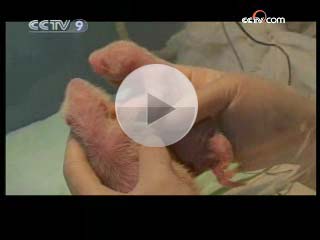------Program code: NS-081014-02944 (what's this?)
Source: CCTV.com
10-14-2008 10:31
In the northern suburbs of Chengdu is a grove of bamboo. Over 60 pandas have been living there. For 30 years, pandas have been born between summer and autumn.
 |
On the morning of August 23, 2003, we went to the Chengdu Research Base of Giant Panda Breeding. We saw several pandas playing. Earlier, I used to think pandas were harmless and cute. They usually sit still, eat bamboos, and don’t move. However, one of these pandas grabbed our tripod and began to gnaw on it.
They were all born last year; they’re almost one year’s old. It was their play time. Several pandas will be born this year. They will have brothers and sisters then.
 |
News came from the delivery room that Er Yatou would give birth soon.
In the last four years, Er Yatou has been pregnant twice but has never been a mother.
With her first pregnancy she was carrying twins. But they died a short time after they were born.
With her second pregnancy, she gave birth to a stillborn male panda. This was her third pregnacy. Would she get to be a mother this time? Director Huang who was in charge of the delivery room stayed with Er Yatou throughout the night of August 22.
Usually, once her water breaks, the baby panda appears soon after. There should be over 100 contractions. It’s abnormal for her to only have two. Director Huang began to worry and doubt her pregnancy.
We know little about panda propagation. After they started to breed in captivity, the researchers have been observing and recording their propagation habits and techniques to increase their propagation rate. Er Yatou not only had too few uterine contractions, but also seemed too calm.
At 12 o'clock on the night of August 23, 15 hours passed after Er Yatou's fluid broke. The researchers were even more puzzled. Usually, a baby panda is born within three or four hours after the amnionic fluid breaks. The calmer Er Yatou was, the more worried the researchers were. Why did she give birth so slowly? Was there really any cub?
The researchers decided to give Er Yatou an ultrasound. She needed to be put under anesthesia, but it couldn’t be for too long as this would be dangerous for mother and baby. It had to be done quickly. They invited an expert from the Obstetrics and Gynecology Hospital to do the ultrasound.
Normally, in four or five months of pregnancy, the mother panda couldn't support two lives because of the lack of food and nutrition. The mother panda has to give birth to a baby panda that isn’t well-developped. The baby panda is premature, only weighing 1/900 of the mother. For this reason, dystocia rarely happens. Ironically, it happened to Er Yatou. Maybe she was still sad from the last two pregnancies. Nobody knows whether the baby will be alive or not.
At the same time, they were learning the reason for her dystocia. The genes of father impacts the baby's development. Who was the father of this baby panda? The researchers checked the record and found two male pandas had a close relationship with Er Yatou. They are Ha Lan, 21 years old and Ke Bi,13 years old. Was her mating with these two pandas the reason for her dystocia? Er Yatou's mate was Halan then, but the researchers had planned she mate with Ke Bi.
From research, they found that female pandas in captivity have to mate at least twice to become pregnant during their estrus. Er Yatou selected Halan the first time and did artificial insemination with Ke Bi's sperm the second time.
These two male pandas were not selected casually. There is a family profile of the pandas at the base, recording their relationship, health status and their personalities.
If the inbreeding coefficient is zero that means there’s no relationship between them. They can breed. After careful selection, the researchers chose Ha Lan and Ke Bi. How could you tell who is the father?
The researchers needed to analyze Ha Lan and Ke Bi's DNA in order to find a genetic defect. The genetic defect in any panda would cause the baby's abnormal development.
After careful testing, it was found that both Ke Bi and Ha Lan were very healthy. Also, they had healthy offspring with other female pandas.
Time passed and the workers felt more worried about Er Yatou. Suddenly, something unusual happened.
If we are going through a difficult childbirth we have a cesarean delivery. The problem is easy to solve. But for pandas, how could they help her? Could we use the same method?
Another day began, Er Yatou was still very quiet. How about the baby panda? Was it well?
This was terrible. It was dangerous for Er Yatou to have a dead baby in her body. It had to be removed quickly. In the worst possible situation, Er Yatou could die from an infection. Could they take the baby out through inducing labor? Would it be safe for Er Yatou?
The corpora uteri of pandas are much longer. Inducing labor couldn’t be with the usual equipment. Surgery was their only option. The researchers used an oxytocic hormone and other medicines to relax her uterine to force the baby out. But after two days, there was still no improvement.
The dead baby was like a bomb threatening Er Yatou’s life. Nobody knew what would happen next. At eight o’clock in the morning, the keeper found that Er Yatou were sitting still and licking something.
It was surprising that she had eaten her cub. This had never happened before at the centre.
The pandas usually eat the caul and umbilical cord after giving birth. Er Yatou mistakenly treated the dead baby as a secretion and ate it. She was depressed over the next few days. We saw that pandas also have emotions like humans.
After checking the medical records, in the past four years, Er Yatou was unable to give birth to a healthy cub. The male pandas mating with her differed. There must be something wrong with her.
Taking into consideration Er Yatou’s sad situation, we started to doubt the pandas were used to living in captivity. 10”
Editor:Yang
